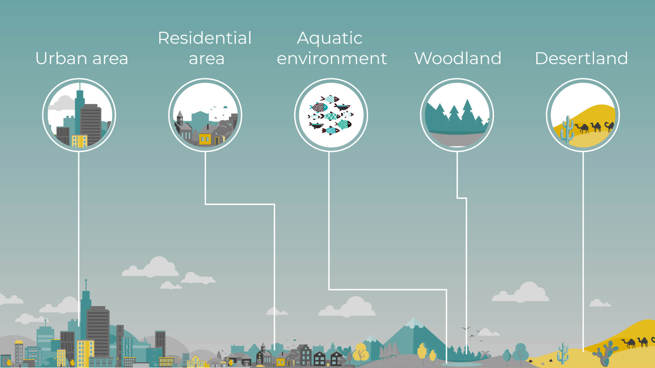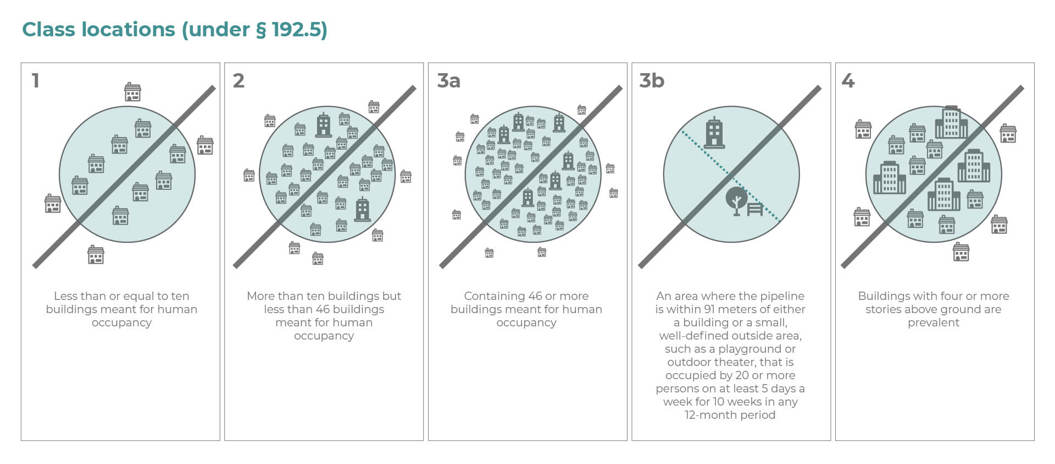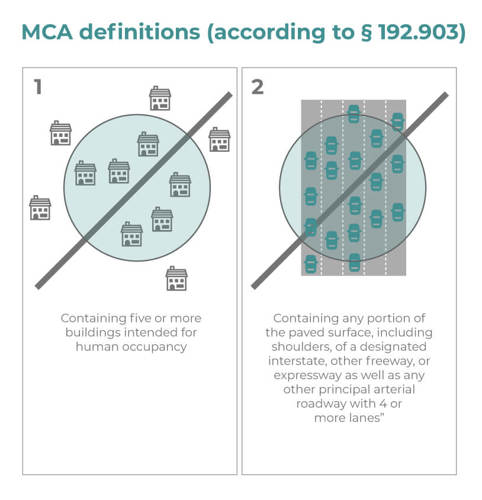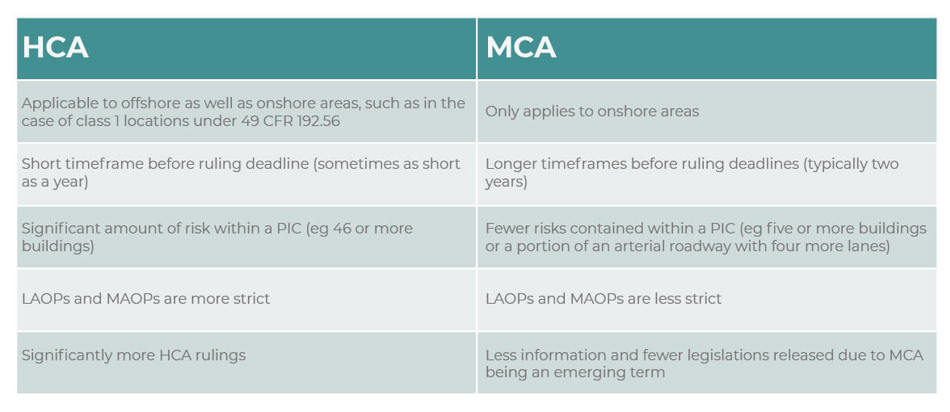Here, there and everywhere: the global pipeline network
Pipelines remain the safest means of transporting any gas or liquid and there are ongoing plans to build new pipeline networks while expanding existing ones. The North American natural gas transmission network is on track to reach a total of 601,253 miles (967,623 kilometers) by 2025.1 However, when building a pipeline or expanding a pipeline network, it’s nearly impossible to avoid high-risk areas that would be particularly devastated in the event of a pipeline leak, rupture or explosion.

Figure 1: Examples of high-risk areas a pipeline can pass through
PHMSA: Giving the risks a name
In an effort to define pipelines constructed close to high-risk areas and ensure they operate under the safest conditions, federal regulators such as PHMSA have introduced the terms high consequence areas (HCAs) and moderate consequence areas (MCAs) with set criteria and rules.
High consequence area (HCA)
PHMSA frequently creates regulations for HCAs that require operators to meet defined safety standards by having the necessary extra safety features or precautions in place before the deadline.
According to the US Department of Transportation (DOT), a HCA is a location where a pipeline release, such as a leak or rupture, would have significantly more impact on the health and safety of the surrounding area than in other, lower risk locations.2
The definition of a HCA is one or more of the following:
1. An area defined as:
a) A Class 3 location under § 192.5
Any class location unit* containing 46 or more buildings intended for human occupants or an area where the pipeline is within 91 meters (300 feet) of either a building or a small, well-defined outside area, such as a playground or outdoor theater, that is occupied by 20 or more persons on at least 5 days a week for 10 weeks in any 12- month period.
*A class location unit is an offshore area that covers 200 meters (660 feet) on either side of the centerline of any continuous 1.6 kilometer (1 mile) length of pipeline
b) A Class 4 location under § 192.5
Any class location unit where buildings with four or more stories above ground are prevalent.
c) Any area in a Class 1 or Class 2 location where:
The potential impact radius (PIR) is greater than 200 meters (660 feet) and the area within a potential impact circle (PIC) contains at least 20 buildings meant for human occupancy.
A class 1 location is an offshore area or any class location that has 10 or less buildings meant for human occupancy while a class 2 location is any class location unit with more than 10 but less than 46 buildings meant for human occupants.
A PIC is a circle of radius equal to the potential impact radius (PIR), which means the radius of a circle which contains a point on the pipeline where potential failure could have significant impact on people or property.
Calculating the PIR involves the following formula:
r=0.69√(p×d2)
- r is the radius of a circular area surrounding the point of failure
- p is the maximum allowable operating pressure in the pipeline
- d is the nominal diameter of the pipeline
d) Any area in a Class 1 or Class 2 location where:
The potential impact circle contains an identified site. An identified site includes the following:
- An outside or open structure occupied by at least 20 people for at least 50 days in any 12 month period and includes examples such as beaches, camping grounds and stadiums
- A building occupied by at least 20 people on at least five days a week for ten weeks in any 12 month period and includes examples such as religious facilities, general stores and roller skating rinks
- A facility occupied by people who are confined, have mobility issues or would be difficult to evacuate. Examples include hospitals, prisons and retirement facilities

Figure 2: The criteria for class locations 1-4 (under § 192.5)
2. A HCA can also be defined as the area within a PIC containing:
At least 20 buildings intended for human occupancy (unless the exception in 4. applies) or an identified site.
3. If a PIC has been calculated using 1 or 2, to establish the HCA:
The length of the HCA “extends axially along the length of the pipeline from the outermost edge of the first potential impact circle that contains either an identified site or 20 or more buildings intended for human occupancy to the outermost edge of the last contiguous potential impact circle that contains either an identified site or 20 or more buildings intended for human occupancy.”
4. If 1c or 2 have been used to identify the HCA:
The radius of the PIC will be greater than 200 meters (660 feet) and the operator may identify a HCA based on “a prorated number of buildings intended for human occupancy with a distance of 660 feet (200 meters) from the centerline of the pipeline until December 17, 2006.”3
High Consequence Areas: a summary
In terms of pipeline incidents, a HCA is at the higher end of the risk spectrum due to the PIC containing hazards which range from buildings and facilities with occupants to outside or open structures.
While pipeline companies should pay extra attention to HCAs and take appropriate actions as part of pipeline integrity management and regulation compliance programs, MCAs are also a common factor in a pipeline route and need attention.
Moderate consequence area (MCA)
When RIN 1 was introduced as part of PHMSA’s new gas rule in 2019, a definition was established for MCAs which, while not meeting the criteria for a HCA, are still within a PIC so the pipeline in question still has the potential to severely affect people, property and the environment.
Much like with HCAs, identifying MCAs involves calculating the PIR to create the potential impact circle which will identify the MCA variables.
PHMSA sets two conditions that must be true for a MCA, including:
- An onshore area within a potential impact circle, according to § 192.903, and containing either:
- “Five or more buildings intended for human occupancy; or
- Any portion of the paved surface, including shoulders, of a designated interstate, other freeway, or expressway as well as any other principal arterial roadway with 4 or more lanes”4,5
- “The length of the moderate consequence area extends axially along the length of the pipeline from the outermost edge of the first potential impact circle containing either 5 or more buildings intended for human occupancy; or any portion of the paved surface, including shoulders, of any designated interstate, freeway, or expressway, as well as any other principal arterial roadway with 4 or more lanes, to the outermost edge of the last contiguous potential impact circle that contains either 5 or more buildings intended for human occupancy, or any portion of the paved surface, including shoulders, of any designated interstate, freeway, or expressway, as well as any other principal arterial roadway with 4 or more lanes.” 4

Figure 3: Two definitions for moderate consequence areas according to § 192.903)
HCAs vs MCAs: what’s the difference?

For assistance demonstrating compliance with HCAs and MCAs, opt for a regulation compliance service
With new rulings being constantly introduced by PHMSA, some with more stringent deadlines than others,7 it’s important for pipeline companies to make sure they’re doing everything they can to protect their network and the surrounding people, property and the environment by taking the appropriate actions if segments of their pipelines run through HCAs or MCAs.
Learn more about regulation compliance support at Atmos
Leak detection regulation compliance service Guidance on leak detection regulations
References
2 https://primis.phmsa.dot.gov/Comm/glossary/index.htm#HighConsequenceArea
3 https://www.ecfr.gov/current/title-49/subtitle-B/chapter-I/subchapter-D/part-192/subpart-O
